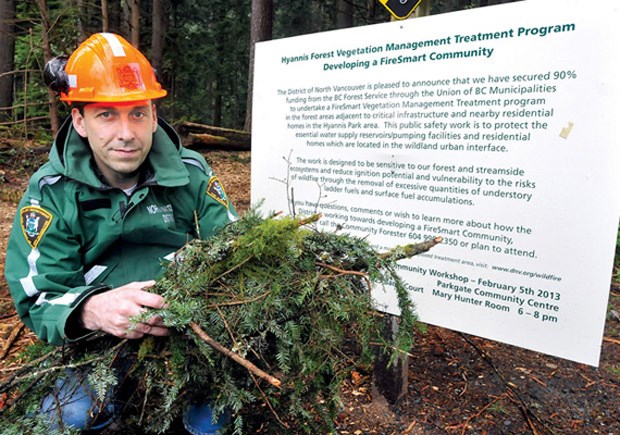CREWS hired by the District of North Vancouver will spend the next three weeks clearing small hemlock trees, dead branches and brush from the forest understory in Hyannis Park to cut down on potential wildfire risk.
The work, being carried out in about seven hectares of parkland north of Hyannis Drive in Blueridge, is part of a joint municipal-provincial program to cut down on fire risk in areas where the forest butts up against residential urban areas.
The risk of interface fires has "been on our radar screens for quite a few years," said Mark Brown, community forester with the District of North Vancouver.
Forest fires in the interior of B.C. that have spread with wind and dry weather to threaten homes and force evacuations of some communities in the past decade have brought those potential risks into focus.
Starting in 2008, the district has been working through a wildfire protection plan to clear fire "fuel" from forest areas regarded as high risk. Previous brushing work has been completed in eight hectares of Grousewoods Park and six hectares at Roche Point Park.
The area being cleared by crews now in Canyon Creek Park and areas of mountain forest above Hyannis Drive was identified as one of the higher fire risks because of the dense understory that could easily spread any fire that broke out, potentially threatening more than 50 homes.
Brown says residents shouldn't fear a chainsaw massacre, however.
Most of the trees being taken out are small hemlocks up to 20 years old, and other understory bush, said Brown.
"We jokingly call it our 'picking up sticks' program," he said.
Larger woody debris will be left in place, while smaller branches will be chipped and used as mulch.
The result is to move the relatively young, dense forest that has grown up since the area was logged in the early part of the century to a stage normally reached later as forests get older, when larger fir and cedar dominate and the spaces between them are more open. "We're just moving things along the natural successional process," said Brown.
A number of larger trees identified as risk for being blown down in windstorms will also either be cut down or have their branches and tops removed, but be retained for wildlife.
The province is picking up 90 per cent of the approximately $100,000 cost of the project and approves all forestry plans. The municipality pays the remaining 10 per cent of the cost.
Prior to starting the clearing this year, staff met with the public in February and mailed notices to all nearby residents.
Crews try to respect wishes of residents who have concerns about retaining some bush as a privacy screen between their back yards and nearby trails.
For the most part, nearby homeowners are supportive of the program, said Brown.
"Most people, once they see the treated area, they are quite enthused about the sunlight in their back yard."



